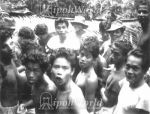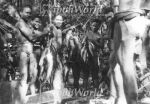We've tried to ensure the information displayed here is as accurate as possible. Should there be any inaccuracies, we would be grateful if you could let us know at info@ipohworld.org . All images and content are copyright.
(Please click on the thumbnail for a bigger image.)
Fort Kemar - The Building Of A Malayan Jungle Fort - Part 3



We were also to be accompanied by D Squadron of 21 SAS from the British army. This squadron with its 4 troops was to be deployed over a large area surrounding the fort, to supply a security screen during construction. An equally important role was to seek out and make contact with the scattered and isolated Aborigine groups in an effort to persuade them to visit the fort site where they would be acquainted with our intentions and asked to help with the fort construction for which they would to be paid.
In order to avoid confusion every military operation is given its own individual designation and the operation to locate a site for, and to build, our fort was to be `Operation Hardcastle`. The name of the Fort was to be decided at a later date.
In mid February 1953 our party, consisting of myself with my platoon and accompanied by our Company Commander Gary Lockington, left our camp on the bank of the Sungei Perak and, following the river, marched for the Sungei Temengor, a tributary of the Sungei Perak, deep in the interior of the jungle-covered hills which run, like a spine, down the centre of the country. We also had with us a small advance party of the SAS, the main body of which was to march in three or four days after us.
This was just before the introduction of troop-carrying helicopters and the march in, carrying a full scale of weapons and packs weighing between 40 and 60lbs was arduous and exhausting. Two words can best describe life in the jungle in these circumstances - wet and stinking. Wet from rain or sweat or both, and stinking because one wears the same clothes day after day for the duration of an operation, changing into a dry set, kept in ones pack, only at night. One of my most abiding memories of life in the jungle, even after half a century, is of changing, upon getting up in the morning, from the warm dry clothes in which I had slept, into my cold, wet and stinking jungle-green uniform, which had hung, overnight, from a dripping bush outside my basha. But God help the man who was tempted to keep his spare dry clothes on!
To march following rivers in the jungle, in hilly country, is especially difficult, and even more so in a country where there is so much rain. The track, if there is one, is invariably narrow and, more often than not, on a steep hillside, often with a precipitous drop down to the river and, for the men in the rear, deep in the mud churned up by those in front. There are massive fallen trees to climb over - not easy when carrying a full pack and a sidearm - and every two or three hundred yards, a stream to wade through, often waist deep. On tracks used by the Asli one would sometimes find a short cut across a long loop in the winding river, but this meant climbing the hill which had caused the river to loop in the first place.
The tracks are also infested with mosquitoes and leeches, the leeches hanging from the leaves of the undergrowth to drop off onto passing man or animal. One became accustomed to the leeches and unconcerned - we learnt not to pull them off, which often resulted in a nasty difficult-to-heal ulcer. Touched with salt or ash from the previous night`s fire and carried in an ammunition pouch, they would drop off harmlessly. In this way it was possible to remove the more obvious leeches on arms, necks and faces on the march, but not those in inaccessible places - they easily penetrated the laceholes of boots for instance - and these were left to gorge themselves until one stripped off at the end of the day and removed them from bleeding legs, back and stomach, and consigned them to the fire. Mosquitoes, on the other hand, gave one sleepless nights and, if one didn`t take one`s Paludrine religiously - almost certainly, Malaria.
My little Malays took all this in their stride. Not only were the majority of them kampong Malays who were at home in the jungle, but they had also operated in these conditions for over two years and consequently were hardened to it. Not so the SAS troopers and it was by no means the Regiment`s finest hour. It is well documented that the SAS, after its revival for service in the Malayan Emergency, had gone through hard times and many of its troopers were well below the standard which would eventually be required of a man with an aspiration to join the Regiment and which would serve in future years to make them one of the finest Special Forces in the world. A majority of them were unfit, they were unaccustomed at this time to operating for long periods in deep jungle and their discipline left much to be desired. Many of them were what was known in those days, as `Canteen Cowboys`. On the march, several of them collapsed and as my Malays casually stepped over one Irish trooper who lay across the track with his equipment strewn about him, he called out to me “Holy Mary mutter o`God sorr, I`m f…ing-well doyin”!
The pictures show some of the Orang Asli that became involved with the Fort and here Sergeant Yusoff is distributing mail and cigarettes after an airdrop (see Part 6). In the centre they have plenty of fresh fish from the river from one of Dennis' explosive fishing trips and the story behind this photograph is in Part 7. On the right thay are taking part in a traditional celebration dance.
To go to Part 4, click here.
To see a series of photographs about air drops, click here.